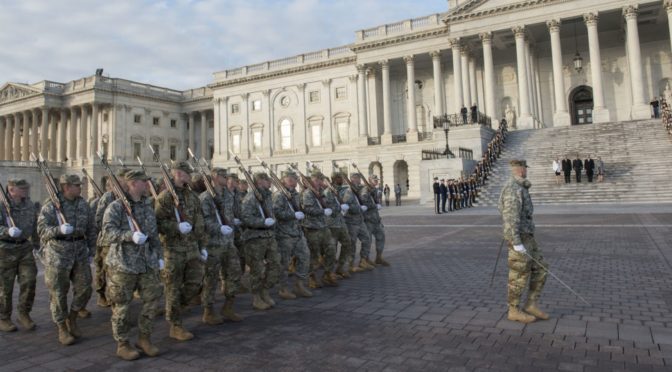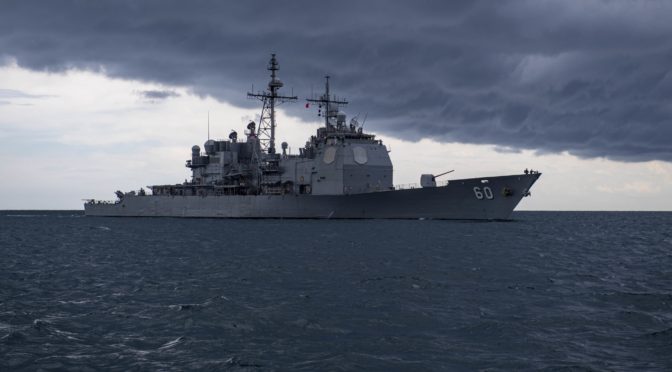By Ben DiDonato
The United States is currently badly divided. It can be seen every day and citizens cannot avoid it in their personal lives. In times like these, it is easy to get drawn into the political fray, and that makes it especially critical to remember the importance of keeping the military apolitical.
As the Center for Strategic and International Studies’ (CSIS) Alice Hunt Friend explained in a 2017 article, “This idea underwrites the peaceful transfer of power between presidential administrations and ensures that the American people can make governance choices free from the threat of coercion.” If the military allows itself to be drawn into domestic politics as a partisan actor, that threat, whether implicit or explicit, will inevitably compromise the integrity of its elections and constitution. Once that happens, it is only a matter of time before there is major disagreement between the politicized military and the opposition, similar to what can be seen today with the schism between Democrats and Republicans. While it is possible the elections will go the politicized military’s way, there will always be major, structural disagreements to be had, and eventually the military will find itself on the losing side of the argument.
The logical outcome of the politicization of the military is a distorted civil-military relationship. It doesn’t matter which party or cause the military aligns with, or the intentions of the officers making the decision to become political. This is completely unacceptable in a democratic society. It is why an apolitical military serving the constitution rather than a political party is an essential foundation of the country. If a politicized military becomes as deeply entrenched as current political parties, it may be unwilling to respect the authority of duly elected officials or accept electoral defeat, which may result in subversion of civilian leadership up to and including a coup.
The American people are smart, perceptive, and aware of this risk even if it is rarely discussed directly. They are constantly watching the military for signs of politicization, and so the military must remain highly conscious of the public’s perceptions of its words and actions. It is not enough for servicemembers to believe in remaining apolitical and avoid explicitly partisan policies or actions. They must constantly be conscious of their public appearance and ensure they maintain the image of impartiality at all times, because that is ultimately what they will be judged on. In some ways, this public perception is even more important than their internal thoughts and policies since that is a part of what the country judges them on. While the data does indicate that the military has been largely successful in remaining apolitical to date, it can never take public opinion for granted because trust is extremely easy to lose, and even more difficult to regain once lost.
Politics must remain a civilian matter, and so servicemembers must keep themselves out of the conversation and trust the American people to resolve the current issues themselves. Servicemembers must remember that division cannot happen with only one side, and they must support the entire country regardless of their personal feelings on any given issue. The American people will come out of these times stronger than ever as with every other major challenge before, and the military must give them the space to do so on their own.
That said, servicemembers all have their own opinions, and must remember that the people around them will fall on all sides of these divides. Whether they serve in the Navy, the Marines, the Coast Guard, the reserves, another service, the civilian government, industry, or simply retired, they must be prepared to support each other regardless of political leanings, race, religion, gender, or any other category they can be put into. They need to remember that some of the people around them are deeply concerned about police brutality against African Americans while others interpret “black lives matter” as “white lives don’t matter.” They need to remember that some people around them believe the media and tech companies are going to be the downfall of the country, while others feel the same about President Trump. They need to remember that people of many religious faiths, including Judaism, Islam, and Christianity may be feeling persecuted for their beliefs. Finally, they need to remember that not everyone fits into neat buckets, and that they should not make assumptions about people’s beliefs or concerns based on characteristics like race or political persuasion. All of these feelings are real to those who experience them, and they need to respect and support all of them, especially if they are leaders.
Servicemembers all need to support each other right now, regardless of their differences, and work together on behalf of all the American people, avoiding even a hint of bias. Remember, the United States is strong, and has proven it will repeatedly grow stronger in the face of adversity. The country will come out of this stronger than before. The American people thrive on diversity of ideas and internal disagreements. The current turmoil is only adding new opportunity to grow and reinvigorate the system American forefathers built. As unlikely as it appears in the moment, it is truly making the country a better place.
However, there is a threat to the country capable of destroying the system and the American way of life from within.
If those in the military community allow themselves to become politicized, they could tear their own country down. It may not be today, and it may not be tomorrow, but if the military becomes a considerable force in domestic politics, it could go from having official yet partisan opinions, to influencing elections, to possibly subverting or outright overthrowing elected civilian leaders.
Servicemembers cannot allow that to happen, and so they must maintain their neutrality, both in image and in policy, and support the entire country. To do this, they must remain conscious that external forces are always acting on them and trying to politically activate servicemembers since they are voting Americans as well. Most of these forces are civilian institutions and servicemembers must not pass official judgment on them or interfere with them because doing so would threaten civilian control of the military.
Unfortunately, there are forces within the military community attempting to politicize it. One example of this is Admiral McRaven’s New York Times opinion piece, which some Americans interpreted as an explicit call for a military coup against the president. But he is far from the only retired flag officer making highly political statements. Regardless of intention or party, these forces directly threaten an apolitical military. Servicemembers must hold themselves to a higher standard, police themselves, and reject these malign influences, because no one else can.
None of this is easy, but so long as servicemembers stand together with all the people around them, be they subordinates, shipmates, coworkers, friends, or family, they can prevail. They can remember that the feelings of all their fellow countrymen are just as valid as their own, even if their concerns are completely opposite to one’s own private opinions, and they can reject the forces attempting to politicize the military. They have stood strong as an apolitical organization all Americans can look up to through many past crises, and they can do so again. The military can maintain its neutrality, and in doing so will support the entire country as Americans work to resolve the current crisis and make the country even stronger than before.
Mr. DiDonato is a volunteer member of the NRP-funded LMACC team lead by Dr. Shelley Gallup. He originally created what would become the armament for LMACC’s baseline Shrike variant in collaboration with the Naval Postgraduate School in a prior role as a contract engineer for Lockheed Martin Missiles and Fire Control. He has provided systems and mechanical engineering support to organizations across the defense industry from the U.S. Army Communications-Electronics Research, Development and Engineering Center (CERDEC) to Spirit Aerosystems, working on projects for all branches of the armed forces.
Featured Image: The U.S. Army Honor Guard marches pass the U.S. Capitol Building during the Pass and Review during the Department of Defense Dress Rehearsal, in front of the U.S. Capitol Building, Jan. 15, 2017. (DoD photo by Air Force Staff Sgt. Sean Martin)



